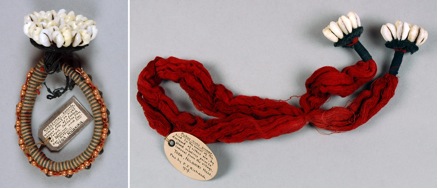Burial ornaments
Toda people, India, early 20th century
 Collected and donated by Frederick John Richards in 1919; 1919.26.16 and 1919.26.19
Collected and donated by Frederick John Richards in 1919; 1919.26.16 and 1919.26.19
The Toda are a small pastoral community who live in the isolated Nilgiri plateau region of southern India. Their culture, society and religion are quite separate from the Hindu majority that surrounds them, although their traditional lifestyle has undergone many changes in the 20th century.
The Toda practice elaborate birth, marriage and burial rites. Traditionally a person would receive not one but two burials. After death, blood relatives prepare the body and dress it with ornaments worn in life. Here is a loop ornament made of black and white striped textile and topped with cowrie shells, worn by a woman on the upper arm. It would have been placed on a female corpse's upper arm correspondingly. The larger red cord ornament is tied to the waist of the deceased of either gender. It is also finished with cowrie shell decoration. The cowrie shell is found in the Indian and Pacific Oceans and is often associated with fertility, commonly used in bodily ornaments in both Africa and southern Asia.
According to Toda tradition, the adorned body is cremated soon after death in the 'first funeral'. The second ceremony, which may take place months or even a year after the first, involves the burial of the ashes and relics reserved from the first funeral, and, until it was outlawed in the 1960s, the sacrifice of buffalo. A stone cairn is raised above the grave and it is only after this second ceremony that the dead begin their journey to the next world.
